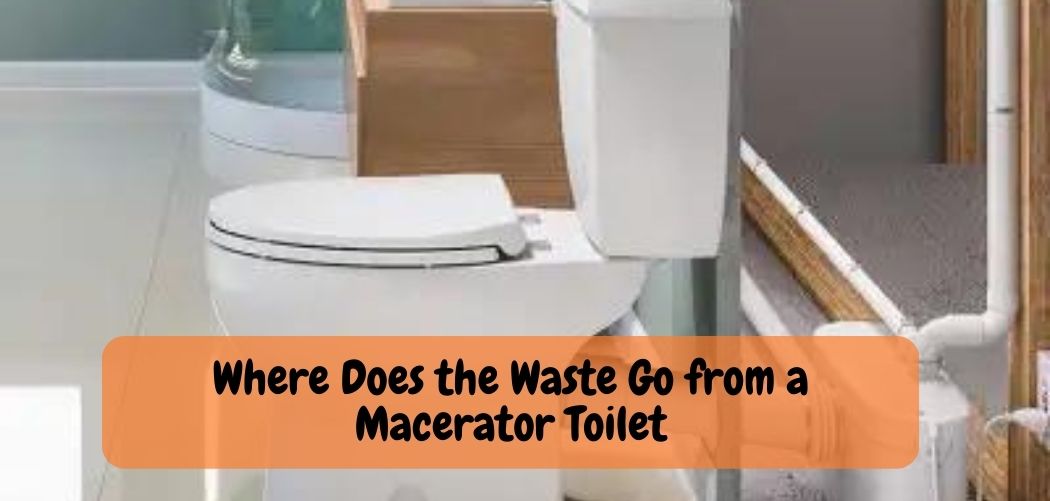The waste from a macerator toilet is transported through a macerator pump, which grinds the solid waste into fine particles and mixes it with water to create a slurry. The slurry is then pumped through a small-diameter pipe, typically 3/4″ or 1″, to the main sewer line or septic system. The small diameter pipe allows the waste to be transported over longer distances and through smaller pipes than traditional plumbing systems.
Macerator toilets are often used in homes or buildings where it is difficult or impossible to install a traditional toilet due to the location or design of the plumbing system. They are also commonly used in basement bathrooms, where it may be necessary to pump waste up to the main sewer line.
It is important to note that macerator toilets are not designed to handle non-biodegradable items such as baby wipes, feminine hygiene products, or paper towels. Flushing these items can cause clogs and damage to the macerator pump and plumbing system. It is recommended to only flush human waste and toilet paper in a macerator toilet to ensure proper functioning and prevent costly repairs.
Macerating Toilet Pros And Cons

There are many advantages to using a macerating toilet, including the fact that they require less water than traditional toilets and can be installed almost anywhere in the home. However, there are also some potential disadvantages to using a macerating toilet that should be considered before making a purchase.
Advantages of using a macerating toilet

One of the biggest advantages of using a macerating toilet is that they require far less water than traditional toilets. Most macerating toilets use only 1.6 gallons of water per flush, compared to the standard 3-5 gallons required by most other toilets on the market. This can save a significant amount of water over time, which is good for both your wallet and the environment.
Additionally, many models of macerating toilets come with dual-flush options that allow you to choose how much water you want to use per flush.
Another advantage of using a macerator toilet is that they can be installed almost anywhere in your home – even in places where there is no existing plumbing. This makes them ideal for remodeling projects or for adding an extra bathroom to your home without having to run new plumbing lines.
All you need is an electrical outlet and a place to discharge the waste water (usually into a nearby sewer line). Macerator toilets also tend to be very quiet, so you won’t have to worry about them disturbing your peace and quiet!
There are some potential disadvantages of using a maceration toilet that should be considered as well.
One issue is that because these toilets grind up waste material, they can sometimes get clogged more easily than traditional toilets if not used properly. It’s important to make sure that only human waste and toilet paper are flushed down the drain – no feminine hygiene products, diapers, or other materials that could potentially clog the system.
Additionally, because macerator toilets rely on electricity to operate, they will not work during power outages unless you have backup batteries on hand.
Macerator Toilet Building Regulations

If you’re considering a macerator toilet for your home, it’s important to be aware of the building regulations that apply. These vary from country to country, so it’s always best to check with your local authority before proceeding. In general though, there are a few things you need to keep in mind.
First and foremost, macerator toilets must be connected to a soil stack or sewerage system. This is to ensure that waste is properly disposed of and doesn’t build up in the unit itself. If you don’t have a soil stack or sewerage connection, you may be able to install a holding tank instead – but this will need to be emptied regularly (at least once a week).
Secondly, the unit must be accessible for maintenance and repairs. This means that it should be located in an easily accessible spot (such as a cupboard under the stairs) and not built into a wall or other hard-to-reach area.
Lastly, there are typically restrictions on where you can place your macerator toilet.
In most cases, it must be at least 1 metre away from any other fixtures such as sinks, baths and showers. This is to prevent cross contamination of the water supply.
So there you have it – just a few things to bear in mind if you’re thinking about installing a macerator toilet in your home!
How Does a Macerating Toilet Work

A macerating toilet is a great option for adding a bathroom to your home without having to run new sewer lines. But how does it work? Here’s a quick rundown:
Macerating toilets have a special grinding unit built into the base of the toilet. When you flush, wastewater is directed into the grinding unit where it is pulverized into a fine slurry.
This slurry is then pumped out through a small pipe (usually about 1” in diameter) to the main sewer line or septic tank.
Since the waste is already in liquid form, it can easily travel through this small pipe – no need for costly and disruptive sewer line upgrades!
What is a Macerator Toilet in an Rv

If you’ve ever been on an RV trip, you know that one of the most challenging aspects can be finding a place to dump your waste. Even if you’re staying at a campground with full hookups, the process of dumping your tanks can be messy and time-consuming. That’s where a macerator toilet comes in!
A macerator toilet is a self-contained unit that grinds up waste and pumps it out through a small hose. This makes it much easier to empty your tanks, since all you have to do is attach the hose to a sewer connection and let the pump do its job. Plus, there’s no need for any awkward maneuvering around tight spaces – the whole process can be done from the comfort of your RV!
If you’re considering adding a macerator toilet to your RV, there are a few things to keep in mind. First, make sure that your RV has enough power to run the pump – it will need either 110v or 12v (depending on the model). Second, consider where you’ll store the hose when it’s not in use – some models come with storage bags or compartments built right in.
Finally, think about how often you’ll need to empty your tanks – if you’ll be doing it frequently, investing in a higher-capacity unit may save you time and hassle down the road.
No matter what kind of RV setup you have, there’s a macerator toilet that will fit your needs. With this helpful tool on board, emptying your tanks will be quick and easy – so you can spend more time enjoying the great outdoors!
Macerator Toilet Problems

If you have a macerator toilet in your home, you may have experienced some problems with it at one point or another. While these toilets are generally very reliable, there are a few things that can go wrong and cause them to malfunction. In this blog post, we’ll take a look at some of the most common macerator toilet problems and how to fix them.
One of the most common issues is clogs. If your toilet becomes clogged, the first thing you should do is check the trap for any foreign objects that might be causing the blockage. If there’s nothing blocking the trap, then the issue is likely with the macerator itself.
To fix this, you’ll need to remove the cover and clean out any debris that has accumulated inside. Another problem that can occur is leaks. If you notice water leaking from your toilet, it’s important to act quickly as this could lead to serious water damage in your home.
The first step is to check all of the connections and seals around the macerator for any signs of wear or damage. If everything looks okay, then it’s likely that there’s a problem with the float switch assembly. This can usually be fixed by simply replacing the float switch assembly with a new one.
If your macerator toilet continues to have problems after following these tips, then it’s best to call in a professional plumber for assistance.
Why Would You Use a Macerator Toilet?

Macerator toilets are a type of sewage treatment system. They are often used in areas where there is no access to a sewer system, or where the soil is too sandy or clay-like to absorb waste water. Macerator toilets work by grinding up waste material and flushing it out through a small pipe.
This process reduces the volume of waste material, making it easier to transport and dispose of.
How Do You Drain a Macerator?

If your home is equipped with a macerator, it’s important to know how to properly drain and maintain it. A macerator is a device that grinds up sewage and waste water so that it can be pumped out of the home through small diameter pipes. Macerators are typically used in homes where the sewer line is too small or there is no gravity-based drainage system.
To drain a macerator, start by turning off the power supply. Then, disconnect the discharge pipe from the unit and open the valve on the bottom of the tank. This will allow all of the water and waste to flow out.
Once the tank is empty, close the valve and reconnect the discharge pipe. Finally, turn on the power supply and run some water through the unit to make sure it’s working properly.
Macerator Toilets – Everything You Should Know
Conclusion
Macerator toilets are a type of toilet that grinds up waste and pumps it out through a small pipe. This type of toilet is becoming increasingly popular in homes and businesses because they take up less space than a traditional toilet and can be installed in places where there is no sewer connection. So, where does the waste go from a macerator toilet?
The answer may surprise you! The macerator process actually starts in the bowl of the toilet. When you flush, the water in the bowl carries the waste down into the macerating chamber where it is chopped up by blades.
The blades chop the waste into very small pieces so that it can be easily pumped out through the small pipe that connects to your sewer or septic system.

